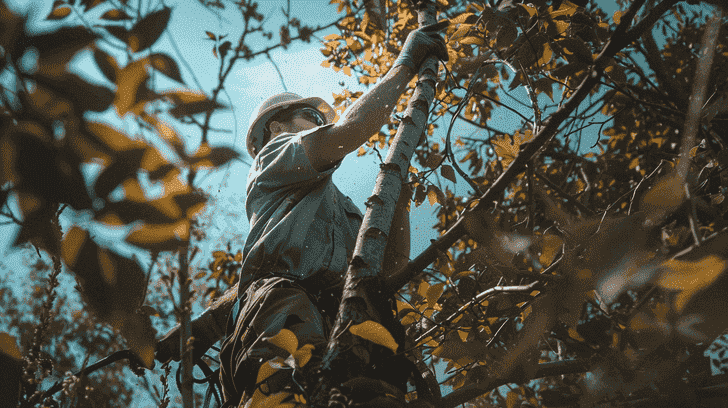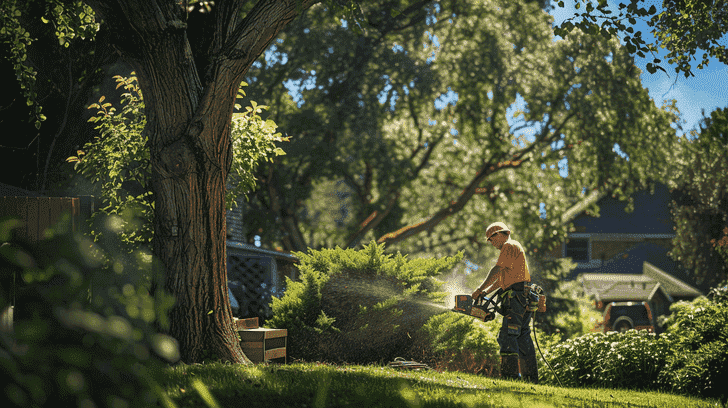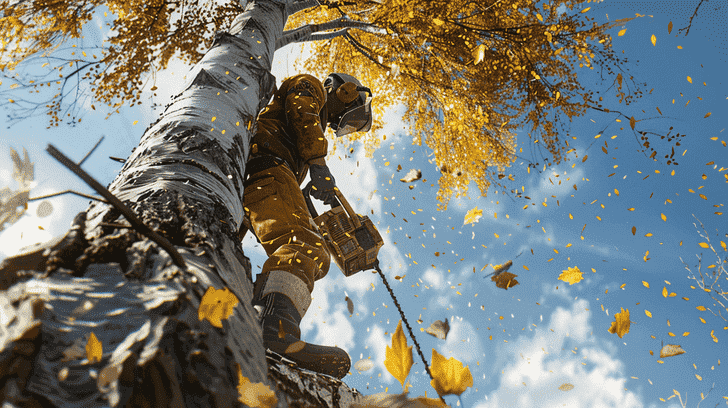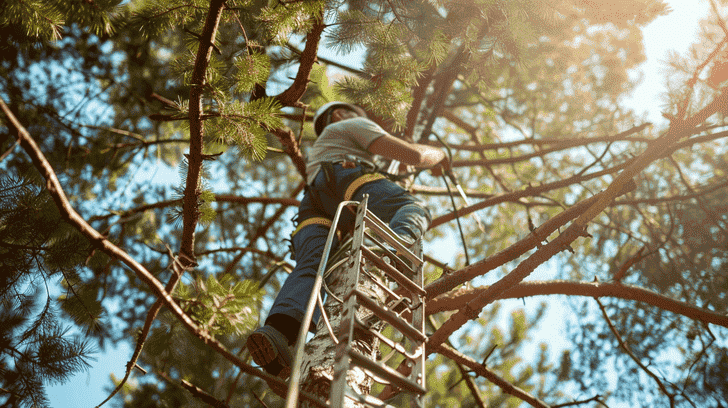Why is Tree Trimming So Expensive?
Tree trimming can seem expensive, but several factors contribute to the cost beyond just manual labour.
Certified arborists bring a wealth of knowledge and expertise to the job, ensuring proper pruning techniques that promote healthy tree growth.
Their training in safety protocols and the use of specialized equipment like cranes or chippers minimize risks and ensure efficient completion.
The complexity of the job also plays a role, with larger trees or those requiring extensive work naturally costing more due to the time and labour involved.
Insurance coverage for both the arborists and your property adds another layer of security but contributes to the overall cost.
Finally, regional variations in living expenses can influence labour rates. While DIY trimming might seem like a cost-effective option for small trees, improper techniques can harm the tree.
In most cases, the expertise, safety measures, and long-term benefits offered by a licensed and insured professional outweigh the initial investment.
Skilled Labor: The Backbone of Safe and Effective Trimming
At the heart of any tree trimming service lies the expertise of certified arborists.
These highly trained professionals possess a deep understanding of tree biology, proper pruning techniques, and the specific needs of various tree species.
Certified arborists can diagnose potential health issues, identify signs of disease or insect infestation, and ensure that trimming practices promote long-term tree health and growth.
Certified Arborists: Knowledge and Expertise
Certification as an arborist requires rigorous training and passing a comprehensive exam, ensuring professionals possess the necessary knowledge and skills for proper tree care.
This expertise translates into several benefits for you. Certified arborists can assess the specific needs of your trees and recommend the most appropriate trimming techniques.
They understand the delicate balance between removing dead or problematic branches and promoting healthy growth patterns.
Their knowledge of tree diseases and insect infestations allows them to identify potential problems early on, saving you money in the long run through preventative measures.
Training and Experience: Ensuring Safety and Efficiency
Beyond their knowledge base, certified arborists undergo extensive training in safety protocols for working at heights.
Tree trimming often involves working with sharp tools on ladders or suspended platforms, creating a potentially hazardous environment.
Arborists are trained in proper rigging techniques, fall protection measures, and the safe use of specialized equipment, minimizing the risk of injury for themselves and those around them.
This training comes at a cost, but it ensures a safe and efficient work environment, ultimately saving time and resources during the trimming process.
Safety Measures: Mitigating Risk and Protecting Your Property
Tree trimming inherently involves working at heights with sharp tools, creating a significant risk of injury. Fall hazards and the potential for struck-by hazards from falling branches necessitate a comprehensive approach to safety.
Risk of Injury: Fall Protection and Awareness
Certified arborists prioritize safety by utilizing fall protection equipment like harnesses, lanyards, and secure anchor points.
Their training emphasizes situational awareness, identifying potential hazards like overhead power lines and ensuring proper footing while working on uneven terrain.
Personal protective equipment (PPE) further minimizes risks, with helmets, gloves, and chaps safeguarding against falling debris and chainsaw kickback.
Time and Effort: Balancing Complexity with Efficiency
The time and effort required for tree trimming significantly influence the overall cost. The complexity of the job plays a major role in this equation.
The Complexity of the Job: From Simple Trimming to Extensive Work
Tree trimming can range from basic crown cleaning, removing dead or diseased branches, to intricate crown shaping for aesthetic purposes.
Large, mature trees with dense canopies or those requiring significant corrective pruning will naturally take longer to trim compared to smaller trees with minimal intervention needs.
Additionally, jobs involving hazardous removals of diseased or storm-damaged limbs require extra time and precautions, impacting the overall cost.
Labour Hours Required: Crew Size and Efficiency
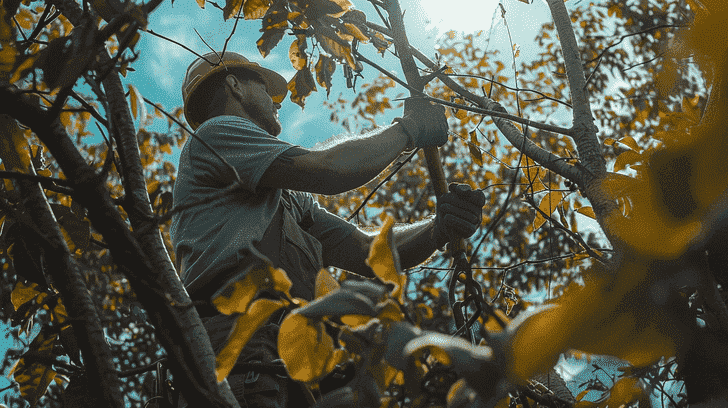
The size and complexity of the job determine the number of crew members needed for efficient completion. Larger crews can tackle intricate tasks or extensive trimming on multiple trees more quickly, but this translates to higher overall labour costs.
Certified arborists can assess the project scope and determine the optimal crew size for both safety and efficiency, ensuring you receive the best value for your investment.
Specialized Equipment: The Right Tools for the Job
Tree trimming often requires a specialized arsenal of equipment beyond basic hand tools. The specific equipment needed can significantly impact the overall cost.
Cranes or Lifts: Reaching New Heights
For large trees with branches that extend beyond the reach of ladders or for jobs requiring extensive overhead work, cranes or aerial lifts become essential.
The rental or ownership costs of this heavy machinery are factored into the service price. Arborists will evaluate the job site and determine the most appropriate and cost-effective lifting solution to ensure a safe and efficient trimming process.
Chainsaws, Chippers, and Other Tools: Investment and Maintenance
Beyond lifting equipment, arborists rely on a variety of specialized tools for efficient and precise trimming.
Chainsaws of varying sizes cater to different branch diameters, while pole saws allow for reaching higher branches from the ground.
Wood chippers efficiently manage the resulting debris, keeping the worksite clean and minimizing waste disposal costs. The investment and maintenance of this specialized equipment contribute to the overall service cost.
Insurance and Liability: Protecting Yourself and the Professionals
Hiring a professional tree trimming service involves a critical safety net – insurance coverage. While the upfront cost might seem like an added expense, it safeguards both you and the arborists in case of unforeseen circumstances.
Worker’s Compensation and General Liability Coverage: Peace of Mind for Everyone
Worker’s compensation insurance protects arborists in case of job-related injuries, covering medical expenses and lost wages.
This ensures the financial well-being of the workers and prevents potential lawsuits against you, the homeowner.
General liability insurance provides coverage for any accidental property damage that might occur during the trimming process.
This protects you from unexpected financial burdens should a branch fall and damage your fence or a neighbour’s property.
By carrying the proper insurance, certified arborists offer peace of mind and demonstrate their commitment to a safe and responsible work environment.
Regional Differences: Cost Variations Across Locations
The perceived cost of tree trimming can also be influenced by regional variations in several factors.
Cost of Living Variations: Urban Premiums and Rural Rates
The cost of living can significantly impact the labour rates charged by professional tree-trimming services. Arborists in urban areas with higher living expenses will likely have higher hourly rates compared to those in rural locations.
This is due to factors like higher rental costs for equipment and office space, as well as potentially higher wages for skilled labourers in urban areas with a competitive job market.
Understanding these regional cost variations can help you set realistic expectations when comparing quotes from different tree-trimming services in your area.
Alternatives and Considerations: Weighing Your Options
While professional tree trimming services offer a range of benefits, understanding the cost factors can help you make informed decisions.
DIY Trimming: A Cost-Effective Option (with Caution)
For small, healthy trees with readily accessible branches, DIY trimming can be a cost-effective alternative. However, this approach requires proper knowledge, appropriate safety gear, and the right tools. Improper trimming techniques can harm the tree’s health and lead to long-term problems.
Before attempting DIY trimming, it’s crucial to assess the risks and your skill level. Consulting with a certified arborist for guidance on proper trimming methods for your specific tree species can be a valuable step, even if you plan to tackle the job yourself.
Hiring a Licensed and Insured Professional: Expertise and Peace of Mind
Hiring a licensed and insured professional arborist service offers the most comprehensive approach to tree trimming.
Their expertise ensures proper techniques are used, minimizing the risk of harm to your trees and promoting their long-term health.
Certified arborists can identify potential problems early on, saving you money through preventative measures. While the initial cost may seem higher, the peace of mind, safety, and long-term benefits often outweigh the upfront investment.

